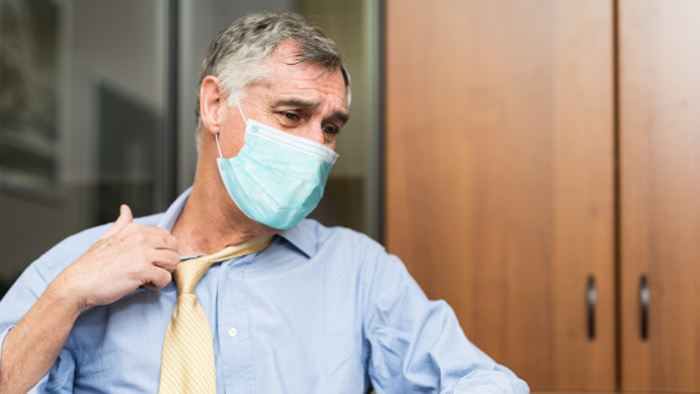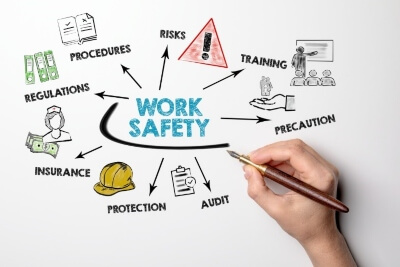Heat Stress – if Heat Isn’t Enough, Toss in a Mask!
May 21, 2021 Occupational Health & Safety Regulations, Safety CultureHello all, it’s a glorious day again for me, and I hope you are also having the same.
It’s getting towards the end of the workweek, the weather is getting warmer – and yes, I am still working from home! As previously discussed, there are pros and cons of “living at work,” but being able to enjoy the weather is definitely in the pro column.
You can move your workstation outside (which I have seen many distance learning participants do – even on a dock a few times), you can do some laundry or dinner prep at lunch, or even start opening your pool while writing a blog!
Now there are a few cons as well to this lovely warm weather we are having too.
The bugs have decided to emerge from their winter hiding place and have resumed their torment of us with a vengeance. You could also have dealt with neighbours who live in their backyard with a 5000-watt sound system going 24 hours a day.
In my case, what I am dreading the most is the onset of the extreme heat that inevitably will come our way.
In our JHSC Part One certification course, we talk about physical hazards. These include noise, vibration, radiation, and of course, heat.

Heat is a hazard in our workplaces, and that is not in dispute here. But I do think there is some room for conversation.
Now, working out in the field, I did work alone for the vast majority of my time. Occasionally there would be a situation where you would go give assistance to a coworker, road crossing/traffic control, troubleshooting a line, etc. When I would be chatting with other workers, they would be so pumped it was hot out! They all loved the heat.
I, in fact, was in so much of the minority, I was mocked for how it affected me.
Don’t feel bad for me by the way, it was all in good fun, and I knew my revenge would be on its way with Jack Frost soon enough. So, I also learned at that job, the cold does not bother me one bit.
Here is where our conversation starts.
Heat affects all workers differently. One control to rule them all (that’s right – a Lord of the Rings reference) doesn’t quite work with this particular hazard as it would, for say, an issue like machine guarding.
There are variables to consider, such as the environment, the type of work being done, how acclimatized to workers are, to name a few. So for some clarity, let’s take a look at what regulation says about temperature and heat.
Temperature and Heat in Ontario Regulations
For our industrial workers, flip open that green book and head to Ontario Regulation 851 S.129. It states
“Subject to subsection (2), an enclosed workplace shall be at a temperature,
(a) suitable for the type of work performed; and
(b) not less than 18° Celsius. R.R.O. 1990, Reg. 851, s. 129 (1).
(2) Clause (1) (b) does not apply to a workplace,
(a) that is normally unheated;
(b) where the necessity of opening doors makes the heating of the area to the temperature specified in clause (1) (b) impracticable;
(c) where perishable goods requiring lower temperatures are processed or stored;
(d) where radiant heating is such that a worker working in the area has the degree of comfort that would result were the area heated to the temperature specified in clause (1) (b);
(e) where the process or activity is such that the temperature specified in clause (1) (b) could cause discomfort; or
(f) during the first hour of the main operating shift where process heat provides a substantial portion of building heat”.
So, if you read into Ontario Regulation 851 for Industrial Establishments, it says that we are in control of enclosed spaces, and it cannot be less than 18 degrees Celsius (64.4 Fahrenheit/291.15 Kelvin) in our workplace.
The regulation also provides caveats to that requirement, such as perishable goods, opening and closing doors, etc.
What you may find odd is that the regulation says NOTHING about how hot it can get. If you switch over to Ontario Regulation 213 for Construction Projects and search heat, you do not really get an answer either. S. 49 tells us about the rules for using temporary heat. It says:
“(1) A fuel-fired heating device shall be located, protected and used in such a way that there is no risk of igniting a tarpaulin or similar temporary enclosure or combustible materials adjacent to it.
(2) No fuel-fired heating device shall be used in a confined or enclosed space unless there is an adequate supply of air for combustion and adequate general ventilation.
(3) A fuel-fired heating device shall be protected from damage and from overturning.
(4) No fuel-fired heating device shall be located so as to restrict any means of egress.
(5) A fuel-fired heating device that generates noxious products of combustion shall discharge the products of combustion outside the building or structure in which it is located”.
I am finding myself at a loss at this point. Am I the one that gets left out of the fold?
My heat-loving colleagues are protected from cold, but I, the few, the proud, the heat hater left in the lurch? Not quite. The Ministry of Labour, Training and Skills Development has my back.
MLTSD – Heat Stress
On their website, you can find a page specifically on heat stress. It gives any member of the Internal Responsibility System the information that must be considered when confronted with the potential of heat stress in your workplace.
Remember, you can’t say you didn’t know if they publish it right on their website.
The MLTSD gives factors that make it worse, like physical work, loss of fluids. They even give you the heads up of common causes like working in direct sunlight in the summer months, humidity in the workplace (more than 50% relative humidity), and working in specific workplaces such as foundries, smelters, chemical plants, bakeries and commercial kitchens.
What they are doing is helping organizations recognize hazards in their workplace.
That is only the first step; you then have to assess, control, and then evaluate – remember the RACE methodology?
Now for the assessment stage, I’ll introduce a new term to you. Wet Bulb Globe Temperature.
That is typically used as a measurement in industrial hygiene to determine the risk to the worker and what controls should then be considered. If that term is new to you, I recommend you take a look at the Canadian Center for Occupational Health and Safety’s website for more information.
Moving on to the controls available to us, we will again see the expectations of the MLTSD. Their website lists “design your workplace to reduce heat stress, plan ahead to reduce heat stress, help workers adjust to hot environments, encourage workers to wear suitable protective clothing, and creating a heat stress plan.”
Now all of these are fantastic ideas, and I’m sure some of you already have these in place – and that’s awesome!
But one thing has just occurred to me. How does this affect the guideline for Covid-19 masks in our workplaces?
I know, I know – we made it this far without talking about the pandemic, but I think this brings up a valid concern that has the potential to cause friction in your workplace as the weather does warm up. In the winter, those cloth masks were like little face scarfs that kept us warm – but what about in the heat?
The last publication about this from the MLTSD was posted October 23, 2020, and updated last on April 30, 2021. It goes through what is acceptable in terms of masks versus face shields as at the source controls and masks being used as personal protective equipment. I would argue that the vast majority of masks being used are for the purposes of at the source control – so the non-medical grade.
The guidance given by the MLTSD is as follows:
Selecting masks
A mask should:
securely cover the nose and mouth
fit closely to the face without gaps
A nose piece that can be moulded to conform to the face may be helpful to ensure a close fit.
Using a mask should not introduce any new health or safety hazards into the workplace, such as masks getting caught in machinery or restricting vision. (Notice how heat stress isn’t mentioned here?)
When choosing what type of mask to use in your workplace, consider:
the purpose of the mask (source control and/or personal protection equipment)
mask qualities that impact your workers’ ability to wear it when needed, for as long as needed (for example, breathability, comfort and durability)
Existing performance standards, such as ASTM International mask standards, can help provide information on mask qualities such as breathability, filtration, and fluid resistance.
Masks used as P.P.E. should be substantial enough to prevent droplet penetration.
Masks used as source control:
May be disposable or reusable
if made of cloth, it should be made of at least two layers of tightly-woven fabric, such as cotton or linen
should not have exhalation valves
So what does this tell us? We have to wear masks; we have to ensure that they catch all the droplets as WE the workers are the hazard source.
It should be comfortable yet secure.
It has to fit correctly and provide a semi-seal.
It can be made of whatever you want as long as it is thick enough to catch all the gooey bits, but it CANNOT have a valve.
Now that valve they speak of, many people have been telling me made it “less hot” while wearing a mask at work. C.B.C. marketplace, I believe, did a report on mask types and clearly stated that masks with valves “can disperse virus particles to others.” So as an at the source control, it is an epic failure.
Going back to the MLTSD’s guidance on protecting workers, they suggested: “encourage workers to wear suitable protective clothing” – so dress for the weather in essence.
My question to you consider both heat stress and Covid-19 protocols – what will happen when workers believe that the mask is becoming a source of heat stress? Will you be providing extra breaks so they can go outside to shady areas and away from others to take it off? Will you provide designated cooling areas where they will be able to cool down with the mask properly donned? Are you going to ignore the issue and hope it goes away?
I think we have a few options.
I have had conversations with clients about their interactions with the MLTSD on this very subject. I have been told that since masks cover such a small percentage of the body’s surface, they are a small consideration when considering heat stress in your workplace.
What is affected is the comfort level of the worker – not necessarily an OHSA violation. There is also the option to consider physical distancing outside. As someone who did work alone in the past, a mask would be a non-issue, providing I can maintain my distance from others.
I think this allows employers to revisit their safe work instructions when it comes to masking workers outdoors.
I am aware that every public health unit has slight differences in requirements, but if at all possible, perhaps physical distancing can be considered as a viable option. I know this is a consideration of my manager at the current time.
There would have to be considerations for productivity levels and enforcement of this new administrative control – but worker comfort does lend itself to higher morale.
If you are like me, you WERE hoping this would be a non-issue.
Unfortunately, the pandemic has stayed longer than we expected. Last summer, a lot of businesses were in panic mode, and work came to a standstill.
We have learned we can safely work one year later if the proper precautions and considerations have been made. So before the weather gets too hot, consider how that will affect your workers wearing a thick non-medical mask all day.
The MLTSD heat stress and their Covid-19 mask page both quote the same statutory obligations, S.25 (2)(h)/S.27 (2)(c) – “take every precaution reasonable in the circumstances for the protection of a worker.”
As a worker that hates the heat – think of me. That reminds me, better go check on that pool pump…
CLICK HERE to download a free ‘Heat Stress Risk Assessment Template’ that you can use to document your heat related risks.
Geoff Rowatt | CHRL
Safety Trainer, Industrial Safety Trainers Inc.





